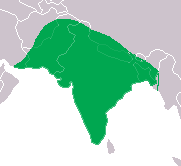Indian eagle-owl
| Indian eagle-owl | |
|---|---|
 |
|
| Adult from Maharashtra, India | |
| Scientific classification | |
| Kingdom: | Animalia |
| Phylum: | Chordata |
| Class: | Aves |
| Order: | Strigiformes |
| Family: | Strigidae |
| Genus: | Bubo |
| Species: | B. bengalensis |
| Binomial name | |
|
Bubo bengalensis (Franklin, 1831) |
|
 |
|
| Range of Indian eagle-owl | |
| Synonyms | |
|
Urrua bengalensis |
|
Urrua bengalensis
The Indian eagle-owl, also called the rock eagle-owl or Bengal eagle-owl (Bubo bengalensis), is a species of large horned owl restricted to the Indian Subcontinent. They were earlier treated as a subspecies of the Eurasian eagle-owl. They are found in hilly and rocky scrub forests, and are usually seen in pairs. They have a deep resonant booming call that may be heard at dawn and dusk. They are typically large owls, and have "tufts" on their heads. They are splashed with brown and grey, and have a white throat patch with black small stripes.
This species is often considered a subspecies of the Eurasian eagle-owl Bubo bubo and is very similar in appearance. The facial disk is unmarked and has a black border, a feature that is much weaker in the Eurasian form. The base of the primaries is unbanded and rufous. The tail bands have the tawn bands wider than the black ones. A large pale scapular patch is visible on the folded wing. The inner claws are the longest. The last joint of the toes are unfeathered.
The taxonomy of the group is complex due to a large amount of variation. Dementiev was the first to consider the possibility of bengalensis being distinct within the Bubo bubo group. However Charles Vaurie noted that this as well as ascalaphus appeared to be distinct and not part of clinal variation. There is a lot of colour variation with the ground colour being dark brown above while some are pale and yellowish. On dark birds the streaks coalesce on the hind crown and nape but are narrow in pale birds. However, Vaurie notes that despite the variation, they are distinct from neighbouring forms B. b. tibetanus, B. b. hemachalana and B. b. nikolskii, in being smaller and richly coloured. Stuart Baker noted that there were two plumage variants that were seen across their range, one plumage has the back and scapulars spotted in white while the other form has a reduced number of white spots on the feathers of the back and the dark streaking on the back, neck and scapulars being prominent.
Chicks are born with white fluff which is gradually replaced by speckled feathers during the prejuvenile moult after about two weeks. After a month or so they go through a prebasic moult and a brownish juvenile plumage is assume with the upperparts somewhat like in adults but the underside is downy. The full adult plumage is assumed much later.
They are seen in scrub and light to medium forests but are especially seen near rocky places within the mainland of the Indian Subcontinent south of the Himalayas and below 1,500 metres (5,000 ft) elevation. Humid evergreen forest and extremely arid areas are avoided. Bush covered rocky hillocks and ravines, and steep banks of rivers and streams are favourite haunts. It spends the day under the shelter of a bush or rocky projection, or in a large mango or similar thickly foliaged tree near villages.
...
Wikipedia

